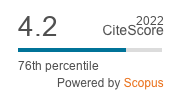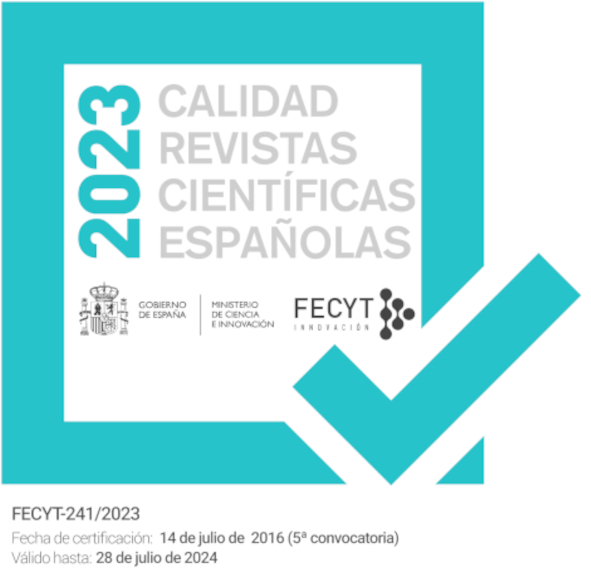Climatic changes and distribution of plant formations in the state of Paraíba, Brazil
DOI:
https://doi.org/10.18172/cig.5044Keywords:
bioclimatic regimes, climate change, Caatinga, Mata Atlântica, ParaíbaAbstract
The state of Paraíba in northeast Brazil contains four of the seven biomes present in the country: Mata Atlântica, Cerrado, Caatinga and Matas Serranas. On the other hand, Amazônia, Pantanal and Pampa were not found in this area. This special situation allows us to analyse changes in the distribution of these four large Brazilian biomes according to bioclimatic conditions, using the methodology of bioclimatic regime types. Based on the analysis of variables from periods of hydric and thermal vegetation stagnation, obtained from hydric and bioclimatic balances, average monthly temperature and rainfall, that methodology enables us to establish a typology of 27 types of bioclimatic regimes and 243 bioclimatic regime subtypes with the 9 Thornthwaite ombrothermal levels. In Paraíba 4 types of bioclimatic regimes are currently identified (mesophyllo, tropophyllo, xerophyllo and eurythermophilous) and 9 subtypes according to ombrothermal levels. In order to analyse the changes, extreme change situations were chosen: a past scenario with the Last Glacial Maximum (40 ky); and an RCP 8.5 climate change scenario for the CMSS 4.0 model for the year 2070. This enabled 3 bioclimatic regime maps of each of the 3 aforementioned situations to be obtained, providing a map of potential distribution of the plant formations of Paraíba state according to the specific field knowledge and bioclimatic mapping obtained for the present. This paper concludes that a retrocession of the Mata Atlântica can be seen from the Last Glacial Maximum up to the present, losing its optimal bioclimatic conditions and therefore remaining in a highly fragile relict situation in the face of anthropic pressure (sugarcane cultivation and urban expansion); an advance toward 2070 of the Caatinga in its shrub form as a predominant formation is indicated by the projection of climate change in 2070 for the analysed situation, specifically resulting from anthropic pressure, in this case due to livestock activities which have affected this biome in Paraíba since the mid-19th century.
Downloads
References
Ab’Saber, A.N. 1977. Problemática da desertificação e da savanização no Brasil intertropical. Geomorfologia 53, 1-19.
Andrade-Lima, D. 1982. Present-day forest refuges in northeastern Brazil. En: G.T. Prance, (Ed.), Biological Diversication in the Tropics. Colombia University Press, New York, pp. 245-251.
Barbosa, M.R.V., Lima, I.B., Lima, J.R., Cunha, J.P., Agra, M.F., Thomas, W.W. 2007. Vegetação e flora no Cariri Paraibano. Oecologia Brasiliensis 11 (3), 313-322.
Behling, H., Arz, H.W., Patzold, J., Wefer, G. 2000. Late Quaternary vegetational and climate dynamics in northeastern Brazil, inferences from marine core GeoB3104-1. Quaternary Science Reviews 19 (10), 981-994. https://doi.org/10.1016/S0277-3791(99)00046-3
Cámara, R. 1997. República Dominicana: dinámica del medio físico en la región Caribe (Geografía Física, Sabanas y Litoral) Aportación al conocimiento de la tropicalidad insular. Tesis doctoral. Universidad de Sevilla. https://idus.us.es/handle/11441/85112
Cámara, R., Díaz del Olmo, F., Martínez, J.R. 2020. TBRs, a methodology for the multi-scalar cartographic analysis of the distribution of plant formations. Boletín de la Asociación de Geógrafos Españoles 85, 1–38. https://doi.org/10.21138/bage.2915
Carvalho, M.G.R F. 1982. Estado da Paraiba. Classificaçao Geomorfológica. Editora universitária da Universidad Federal da Paraiba. Joao Pessoa.
Cole, M. 1986. The Savannas. Biogeography and Geobotany. Academic Press. London.
Fick, S.E., Hijmans, R.J. 2017. Worldclim 2: New 1-km spatial resolution climate surfaces for global land areas. International Journal of Climatology 37 (12), 4302-4315. https://doi.org/10.1002/joc.5086.
Freire, M., Farias A.S., Soares de Araujo, F. 2011. Composição florística e estrutura de um fragmento de vegetação savânica sobre os tabuleiros pré-litorâneos na zona urbana de Fortaleza, Ceará. Rodriguésia 62 (2), 407-423.
Furley, P.A, Ratter J.Á. 1988. Soil resources and plant communities of the central Brazilian cerrado and their development. Journal of Biogeography 15, 97-108. https://doi.org/10.2307/2845050
Gu, F., Karin, A.F., Zonneveld, K.A.F., Chiessi, C.M., Arz, H.W., Pätzold, J., Behlinga, H. 2017. Long-term vegetation, climate and ocean dynamics inferred from a 73,500 years old marine sediment core (GeoB2107-3) off southern Brazil. Quaternary Science Reviews 172 (15), 55-71 https://doi.org/10.1016/j.quascirev.2017.06.028
Hausfather, Z., Peters, G. 2020. Emissions–the 'business as usual' story is misleading. Nature 577 (7792), 618-20. https://doi.org/10.1038/d41586-020-00177-3
Huget del Villar, E. 1929. Geobotánica. Colección Labor, Sección XII, Ciencias Naturales, nº 199-200, Barcelona.
Montero de Burgos, J.L., González, J.L.R. 1974. Diagramas bioclimáticos. ICONA/Ministerio de Agricultura, Madrid.
Moreira, E., Targino, I. 1997. Capítulos de Geografia Agrária da Paraíba. Ed. UFPB, Joao Pessoa.
Morellato, L.P., Talora, D.C., Takahasi, A., Bencke, C.C., Romera, E.C., Zipparro, V.B. 2000. Phenology of Atlantic Rain Forest tres: a comparative study. Biotropica Special Issue: The Brazilian Atlantic Forest (32) 4b, 811-823. https://doi.org/10.1111/j.1744-7429.2000.tb00620.x
Mori, S.A., Boom, B.M., Prance, G.T. 1981., Distribution patterns and conservation of Eastern Brazilian Coastal Forest Tree Species. Brittonia 33 (2), 233-245.
Oliveira P. 1993. The Brazilian Atlantic Rain Forest: An ecological tragedy for Humankind. Global Ecology and Biogeography Letters (39) 1, 30-31.
Paladini, B., Cámara, R. 2015. Retroceso de la mata atlántica en el entorno de Joao Pessoa (Estado de Paraiba, Brasil). Análisis de la Biodiversidad. In: Análisis Espacial y representación geográfica: innovación y aplicación. Departamento de Geografia y Ordenacion del Territorio, pp. 1563-1570, Zaragoza.
Paladini, B. 2016. Deforestación de la Mata Atlántica en el litoral del Estado de Paraíba (Brasil). Cambios ambientales y riesgos geomorfológicos: voçorocas. Tesis Doctorado en Geografía. Universidad de Sevilla, Sevilla.
Peres, E.A., Pinto-da-Rocha, R., Lohmann, L.G., Michelangeli, F.A., Miyaki, C.Y., Carnaval, A.C. 2020. Patterns of Species and Lineage Diversity in the Atlantic Rainforest of Brazil. Neotropical Diversification: Patterns and Processes, pp 415-447.
Peulvast, J.N., Claudino Sales, V. 2004. Stepped surfaces and palaeolandforms in the northern Brazilian «Nordeste»: Constraints on models of morphotectonic evolution. Geomorphology 62 (1), 89-122. http://doi.org/10.1016/j.geomorph.2004.02.006
Porto de Lima, V.R. 2012. Caracterización biogeográfica del bioma de Caatinga en el sector semiárido de la cuenca del río Paraiba, Noreste de Brasil: propuesta de ordenación y gestión de un medio semiárido tropical. Tesis Doctorado en Geografía. Universidad de Sevilla, Sevilla.
Ranta, P., Blom, T., Miemela, J., Joemsuu, E., Siitonen, M. 1998. The fragmented Atlantic rain forest of Brazil: size, shape and distribution of forest fragments. Biodiversity and Conservation 7, 385-403.
Rodrigues, J.S., Castelo Branco J.S., Miranda de Melo, J.I. 2014. Flora de um inselberg na mesorregião agreste do estado da Paraíba-Brasil. Polibotánica 37, 47-61.
Rodrigues de Lira, D., Bezerra de Araujo, M.S., Sa Baretto, E.V., Alves da Silva H. 2010. Mapeamento e Quantificação da Cobertura Vegetal do Agreste Central de Pernambuco Utilizando o NDVI. Revista Brasileira de Geografia Física (3), 157-162.
Riou, G. 1995. Savanes. L’herbe, l’arbre et l’homme en terres tropicales. Masson. Paris.
Rizzini, C.T. 1992. Tratado de Biogeografia do Brasil: aspectos ecológicos, sociológicos e florísticos. Ambito Cultural Edições. Rio de Janeiro.
Ruiz Pessenda, L.C., Marques Gouveia, S. E., Souza Ribeiro A., Oliveira P. E., Aravena R. 2010. Late Pleistocene and Holocene vegetation changes in northeastern Brazil determined from carbon isotopes and charcoal records in soils. Palaeogeography, Palaeoclimatology, Palaeoecology 297 (3–4), 597-608. https://doi.org/10.1016/j.palaeo.2010.12.026
Sampaio, E.V.S.B. 2010. Características e potencialidades. En: M. A Gariglio, E. V. S. B. Sampaio, L. A. Cestaro, P. Y. Kageyama (ed.). Uso sustentável e conservação dos recursos florestais da caatinga. Ministerio do Meio Ambiente, pp. 29-48, Brasília.
Schimper, A.F.W. 1903. Plant-Geography upon a physiological basis. Clarendon Press, Oxford.
Silva, T., Torres, L.M., Furrier, M. 2015. Caracterización geológica y geomorfológica del Municipio de Joao Pessoa, PB. Brasil. Revista Geográfica de América Central 54, 113-134. http://doi.org/10.15359/rgac.1-54.5
Souza, B.I., Cámara, R., Lima, E.R.V. 2015. Caatinga e desertificação. Mercator 14 (1), 131-150. http://doi.org/10.4215/RM2015.1401.0009
Steffena, W., Rockströma J., Richardson K., Lentond T.M., Folkea, C., Livermanf, D., Summerhayesg, C.P., Barnoskyh, A.D., Cornella S.E., Crucifixi, M., Dongesa, J.F., Fetzera, I., Ladea, S.J., Scheffer, M., Winkelmannk, R., Schellnhubera, H.J. 2018. Trajectories of the Earth System in the Anthropocene. PNAS 115 (33), 8252-8259. https://doi.org/10.1073/pnas.1810141115
Tabarelli, M., Santos, A.M.M. 2004. Uma breve descrição sobre a História Natural dos Brejos nordestinos. In: K. C. Porto, J. P. Cabral, M. Tabarelli (ed.). Brejos de altitude em Pernambuco e Paraíba: história natural, ecologia e conservação. Ministério do Meio Ambiente. Série Biodiversidade, 9. Brasília.
Thomas, W.W. 2008. The Atlantic Coastal Forest of Northeastern Brazil. The New York Botanical Garden Press. New York.
Thornthwaite, C.W., Mather, J.R. 1956. The Water Balance. Drexel Institute of Technology, Laboratory of Climatology 8, 1-104.
Thornthwaite, C.W., Mather, J.R. 1957. Instructions and Tables for Computing Potential Evapotranspiration and the Water Balance. Climatology 10, 181-311.
Tuhkanen, S. 1980. Climatic parameters and indices in plant geography. Acta Phytogeographica Suecica 67, 1-108.
Ward, J.D., Mohr, S.H., Myers, B.R., Nel, W.P. 2012. High estimates of supply constrained emissions scenarios for long-term climate risk assessment. Energy Policy 51, 598-604. https://doi.org/10.1016/j.enpol.2012.09.003
Warming, E. 1909. Oecology of plants. An Introduction to the Study of Plant Communities. Oxford University Press, London.
Downloads
Published
How to Cite
Issue
Section
License
The authors retain copyright of articles and authorize Cuadernos de Investigación Geográfica / Geographical Research Letters the first publication. They are free to share and redistribute the article without obtaining permission from the publisher as long as they give appropriate credit to the editor and the journal.
Self-archiving is allowed too. In fact, it is recommendable to deposit a PDF version of the paper in academic and/or institutional repositories.
It is recommended to include the DOI number.
This journal is licensed under a Creative Commons Attribution 4.0 International License











